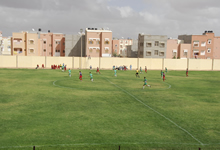 The action of the State is not just limited to education as it is engaged in many endeavors alongside the conventional educational curriculum. This entailed the creation of a complimentary structure for education and training. It deals with deprived children, young people not in school and those who have left the school system. This endeavor has been carried out to the benefit of deprived children, orphans and the disabled. However, it also addresses young people having to cope with problems of adaptation to the new phenomenon of urban living.
The action of the State is not just limited to education as it is engaged in many endeavors alongside the conventional educational curriculum. This entailed the creation of a complimentary structure for education and training. It deals with deprived children, young people not in school and those who have left the school system. This endeavor has been carried out to the benefit of deprived children, orphans and the disabled. However, it also addresses young people having to cope with problems of adaptation to the new phenomenon of urban living.
In addition, public intervention also led to the creation and supervision of educational and work centers, children's homes, social and educational centers and even socially oriented cooperatives. In all these institutions one finds multiple cultural and educational activities. One might cite the example of literacy courses that today constitute a fundamental element of the educational system set up in the many social centers. These centers reach out to wide segments of youth and adults and basic education remains the condition for active participation in the building of a new society.
This also applies to the social and civic education administered to young women and girls. They are also initiated in the practice of certain types of manual labor (sewing, embroidery, weaving). They are therefore given the opportunity to exercise a craftsmanship trade from which they can benefit to increase the family income.
Also to be noted are the children's homes created to accommodate and protect orphans and facilitate their insertion into society. In the same spirit, specialized centers have been created for the disabled and the blind. Not only to they receive constant medical aid, but also available are well-adapted education and training.
To be mentioned in this respect is the determination of the public authorities to truly help underprivileged sectors of society, rather than taking a few limited measures without any real scope, and on the contrary to place everything in the framework of a global endeavor. It is no wonder that this policy has borne fruit and that it has become a decisive factor in their insertion into the general environment and which will not fail to improve their social condition.
Promotion of sports
However, this endeavor to the benefit of youth would be incomplete if it neglected the development of the aptitude for sports. In this field, no efforts have been spared. Football, handball and basketball grounds have been provided in all urban centers. In Laayoune, the multi-purpose hall and swimming pool have bee refurbished.
Spaces reserved to sporting clubs (karate, gymnastics) have been opened. The existence of these types of facility has inspired young people to group together in associations. Some have been set up at the level of city districts that, just for football in Laayoune, represents no less the thirty-two teams. At a higher level, clubs have been organized. There are some twenty football clubs currently joining together nearly 500 license holders for all provinces of the Sahara.
One of the clubs, Chabab Al-Massira (Laayoune), is the glory of these provinces since the time of its rise to the first division national championship. In addition, this promotion gave it the possibility of welcoming international teams.
The role that the provinces of the Sahara are to play in the organization of national and sometimes international meetings is strengthened by the provision of wide ranging infrastructures.
The sports complex of Laayoune, Cheikh Mohamed Laghdaf, inaugurated by His Royal Highness Prince Moulay Rachid in March 1985, can accommodate up to 35.000 spectators. Covering a surface area of 3 hectares, it is provided with several facilities: track and field facilities, group game space and another space of individual sports (boxing, judo, etc.).
This region is returning to its vocation as a top venue for adventuresome sports people performing on land, maritime and air circuits. Three competitions are organized on a regular basis:
The ample deep sea fishing resources along the coastline of the Sahara and the beauty of the beaches dotting them along the way, attract sporting activities linked to the sea, such as deep sea diving, water skiing, surfing, swimming and the international fishing contest in Dakhla.
The integration of the Saharan provinces into the national territory, even though achieved from a physical and economic standpoint, remains first and foremost the integration of people.
This integration, translated in to action by exchanges between the youth of this region and that of other provinces, helps consolidate the cultural unity of the Moroccan nation.